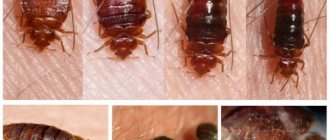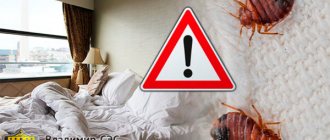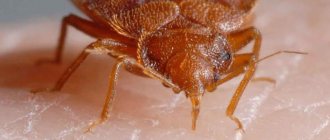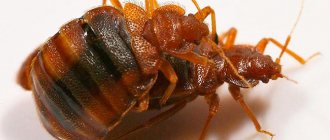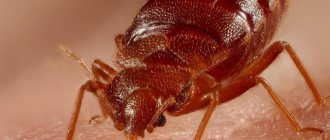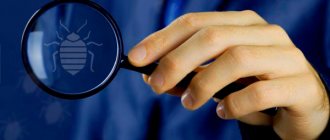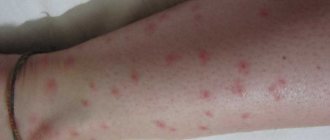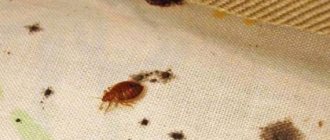Mouthparts and nutrition of bedbugs.
All representatives have a similar structure of the oral apparatus. The oral limbs form the alimentary canal, through which food is absorbed, and the salivary canal, through which saliva is injected. The maxillae and mandibles form a tuft running in the food canal and may have teeth or serrations at the ends. Solenophagous bugs. They apply the mouthparts to the host’s skin and anchor themselves with the jagged ends of the mandibles; moving the maxillae, they penetrate into the skin tissue and reach the blood vessel. Like lice, bedbugs depend partly for their nutrition on symbiotic bacteria. The bacteria are found in the intestinal epithelial cells of triatomine bugs; in cimicids, the bacteria are found in special two disc-shaped organs (mycetomes) in the abdomen on either side of the gonads. There is no evidence that these bacteria cause any harm to bedbugs. At the very least, mutualistic intestinal bacteria are necessary for the normal development of triatomine bugs - with artificial “disinfection” of bacteria, the bugs reach only the second or third stage of development and die.
Animals
The order BUGS (Hemiptera) or Hemiptera represent the largest order of insects with incomplete metamorphosis. Currently, over 30,000 species of bedbugs are known, distributed throughout the globe. They received their name hemiptera due to the peculiar structure of the front wings, which are sharply different from the hind wings, having the appearance of transparent membranes with a small number of veins. The forewings are transformed into elytra, heterogeneous in the degree of their chitinization. The main part of the elytra consists of hard chitin, while the apical part is membranous and the veins on it are clearly visible. Some species of bedbugs are characterized by so-called wing dimorphism, the essence of which lies in the fact that, along with full-winged individuals with fully developed wings and elytra, they also have short-winged individuals. Thus, in males of the pine beetle bug (Aradus cinnamomeus), the elytra are normally developed, the second pair of wings is absent, while females are found in two forms - long-winged and short-winged. The long-winged female has both pairs of wings developed and is capable of flight, while the short-winged female cannot fly, since her elytra are shortened and wings are completely absent. Cases of complete loss of wings by bedbugs are much less common, as is the case, for example, with the bedbug (Cimex lectularius). In addition to the structure of the elytra, a characteristic feature common to all representatives of this order is their piercing-sucking mouthparts, which have the form of a proboscis extending from the anterior edge of the head and not fused with the prothorax. The main part of the proboscis is represented by a strongly elongated, jointed lower lip, forming a deep groove on the inside, in which strongly modified upper and lower jaws are placed, having the appearance of thin and long bristles. The top of the proboscis is covered by a relatively short upper lip. In connection with this specific structure of the oral apparatus is the feeding pattern of hemiptera: by piercing the integument of the body of an animal or plant, bugs suck out blood or cell sap. In this case, the puncture is made by the upper jaws, and suction occurs with the help of the mandibular bristles, which, when immersed in the victim’s body, tightly close, form two channels located one above the other. Liquid food is sucked through the upper channel, which is wider, and the saliva secreted by the bug flows down the lower channel. The lower lip does not penetrate the fabric and plays the role of a case that protects the bristles. In herbivorous bugs, the proboscis is usually long and thin; in a calm state, it is tucked under the body and hidden in a special groove located on the head and chest; in predatory species, the proboscis, on the contrary, is short, but thick and strong, arched in the form of a beak.
The size and shape of the body of hemipterans are extremely variable. Along with small species, less than 1 mm in length, there are very large bugs, reaching 10 cm. The shape of the body often depends on the lifestyle of the bugs and the nature of the environmental conditions in which they live. Usually the body is moderately flattened, more or less rounded, with wings folded flat on the back. Sometimes it takes on a rod-shaped form, and this occurs in various families. The South American stick insect (Ghilianella filiventris) looks more like a stick insect than a bug. At the same time, there are species with an almost regular spherical shape; the latter is characteristic mainly of bugs that live in the thickness of sand on dunes or on hilly sand in deserts. In such psammophilous species from the family of earthen bugs (Cydnidae), the spherical shape of the body is combined with digging limbs, peculiarly adapted for movement in the thickness of loose sand (p. Stibaropus species, etc.) - Strong flattening of the body is observed in parasitic bugs (parasites of bats, birds and humans), as well as in species living under the bark of trees, in the passages of bark beetles and under other shelters. The coloration of hemipterans is often dominated by bright colors in contrasting combinations (black, yellow, red, etc.), which makes them noticeable against the surrounding background. A similar coloration is characteristic, for example, of the skinny bug (Lygaeus equestris) and the soldier bug (Pyrrhocoris apterus). The skinny bug is bright red with a black pattern and white spots on the upper side of the body, the antennae and legs are black; length 10-12 mm. Already in early spring it can be found in large quantities on the walls of houses, on the bark of trees and on various herbaceous plants. The soldier is approximately the same size, red with a black belly and a black pattern on the elytra; its elytra are somewhat shortened, and its wings are often completely absent. Such a bright color is clearly of a demonstrative nature and goes well with the presence of odorous mammary glands in bedbugs, which secrete a specific liquid with a sharp, characteristic “bedbug” odor. The paired openings of the ducts of these glands open on the metathorax between the places of articulation of the second and third pairs of legs. The secretion secreted by the glands is acidic; its unpleasant odor is determined by cimicic acid C15H2802. In bugs that live in aquatic environments, as well as in a number of predatory species, scent glands are absent or poorly developed. Despite the fact that many species of hemipterans are found in nature in large quantities, the fertility of their females is generally low and ranges from several dozen eggs to 200. Eggs can have an oval, cylindrical, spindle-shaped or irregularly rounded shape. Their characteristic feature is the presence of a special cap on the upper pole, which opens when the first instar larva emerges from the egg.
Some bedbugs have a distinct form of caring for their offspring. In this regard, the leaf-leaf edger (Phyllomorpha laciniata), found in the Caucasus and Crimea, is interesting. Its pronotum and abdomen are expanded and bear leaf-shaped translucent lobes; antennae, legs and the entire surface of the body are covered with numerous long spines. The ocher-yellow color and leaf-shaped shape make it look like a leaf that has dried out and cracked at the edges. The female lays her eggs on the dorsal surface of the male, where they become stuck between the spines and remain there until the larvae hatch. The number of larval stages in hemiptera is in the vast majority of cases five, rarely four. Postembryonic development lasts from several weeks to two years. The larvae are similar in appearance to the adults, from which they differ primarily in their smaller size and a number of morphological characteristics (the absence of simple eyes, a smaller number of segments, antennae and paws, etc.). The wing rudiments appear in third instar larvae; with each molt they increase in size, but even in fifth-instar larvae they occupy a lateral position and do not touch along the inner edge. Hemipteran larvae also have odorous glands, numbering 1-3 pairs, but the ducts of these glands open on the dorsal surface of the abdomen. The most ancient finds of insects identical to the modern order of Hemiptera date back to the Mesozoic era, where they were mainly represented by specific families not found later in either the Tertiary or modern fauna. In the Tertiary period, at least from the lower Oligocene, most modern families of bugs became isolated.
Currently, there are approximately 50 families, of which about 40 (over 2000 species) are found in Russia. The vast majority of species inhabit predominantly tropical and subtropical regions of the globe. Among bugs there are many species that are predatory or have a mixed diet, but herbivorous forms predominate. Some of them are dangerous pests of agricultural forest plants.
Family Cimicidae - bed bugs.
About 20 species. Small wingless bugs that feed on the blood of warm-blooded animals, primarily birds or rodents. Cimex lectularius, C.hemipterus, Leptocimex boueti are known as bed bugs and attack humans. Cimex lectularius is a cosmopolitan species, but is predominantly found in temperate latitudes; C.hemipterus is more inclined to tropical areas; The distribution of Leptocimex boueti is limited to Western Africa. All three species that feed on humans also feed on bats. Bed bugs are not known to transmit any human diseases, but can be extremely annoying. People chronically attacked by bed bugs suffer from lack of sleep, ulcers at the site of bites, iron and hemoglobin deficiency, and, sometimes, due to mechanical transmission of the hepatitis B virus. Cimex hemipterus was experimentally infected with the human immunodeficiency virus, which remained viable in the bedbug within 8 days. The causative agents of a number of vector-borne diseases can remain alive in the body of bedbugs for a long time, but their role in transmission has not been proven. Bed bugs never defecate on the host's body. Morphology of bedbugs of the family Cimicidae. Tsimicides are red-brown bugs, up to 8 mm long. Flattened dorsoventrally. Their limbs do not have special devices for clinging to the host, but they allow the bedbugs to run quite quickly; bedbugs do not stay on the host for longer than 5-10 minutes. They absorb about 7 mg of blood at a time. Adults do not have wings, although nymphs develop rudimentary wings. Tsimicids have conspicuous compound eyes, but they do not have ocelli. The first thoracic segment forms a rim around the back of the head. The width of the tergite of the first somite of the chest exceeds its length. On the ventral side of the third somite of the chest, odorous glands open, secreting an oily secretion with an unpleasant odor characteristic of bed bugs. The smell probably serves as protection against predators.
Squad of bedbugs
Bugs (Heteroptera) are insects with incomplete metamorphosis; they are representatives of the order Hemiptera. The group includes almost 40 thousand species. The spread of insects is not limited even by harsh climatic conditions. One of the species Nysius groenlandicus lives in Greenland, Canada, Chukotka and Kamchatka. A characteristic feature of the order is the structure of the imago elytra. Their upper part is leathery, and the lower part is transparent, membranous.
Information. The international name of the order Heteroptera was proposed in 1810 by Pierre André Latreille.
Scientists divide the order of bedbugs into 7 information orders:
- Cimicomorpha is the largest, comprising half of all existing species (20,000). It includes the bed bug family.
- Dipsocoromorpha – small individuals up to 4 mm.
- Enicocephalomorpha are bugs with an elongated head, similar to predators.
- Gerromorpha – water striders, bugs living on the surface of water bodies.
- Leptopodomorpha – 320 species up to 8 mm long.
- Nepomorpha – aquatic bugs (2100 species), worldwide distribution, with the exception of Antarctica.
- Pentatomomorpha is the most numerous group; shield insects belong to it.
Bed bugs, like other hemipterans, are insects with incomplete metamorphosis. Fertilized females lay eggs, from which larvae or nymphs emerge. Before sexual maturity they go through 5 instars and 4 molts. From the age of 2-3, the offspring begin to develop the rudiments of wings.
Among the 50 families of the order there are herbivorous, predatory and blood-sucking species. All hemiptera have the following characteristics:
- The presence of a durable chitinous shell that protects internal organs from external mechanical and chemical damage.
- The piercing-sucking structure of the oral organs.
- Similar body structure features: 3 pairs of limbs, 2 pairs of wings (may be absent), scutellum.
- Scent glands that repel enemies and attract mating partners.
Most ground bugs have a dark or green protective coloration. But several species are distinguished by a bright red color in the outer cover. Such insects contain toxic substances in their bodies. The coloring signals this to birds of prey, reptiles and other predators. Herbivorous berry stink bugs have adapted to change the color of their cover with the seasons.
Based on their habitat, insects are divided into two large groups: terrestrial and aquatic. Land dwellers mainly eat plant foods. Among the phytophages, there are species that cause significant damage to household plots and agricultural lands. They suck out the sap of plants, causing their deformation, stunted growth, and sometimes death.
Several families of bedbugs feed on small insects - caterpillars, aphids, and beetle larvae. Predators are used as a biological method of pest control. Bugs of the genus Anthocoris destroy ticks, Oriuses eat the eggs of butterflies and thrips in greenhouses, blue stink bugs exterminate leaf beetles. Some species of Coleoptera have chosen an aquatic lifestyle; they are also predators.
Some species prefer to feed on the blood of people and animals. These include the family bed bugs (Cimicidae), order Hemiptera, class insects. This small group of parasites includes 100 species. Representatives of the family are distributed throughout the world, they attack people, small mammals, bats, and birds. The blood-sucking insect is known in all countries. Its appearance has long been not associated with unsanitary conditions; the spread of bedbugs is facilitated by climate change, mass migration, and tourism.
The bedbug is an obligate synanthropic insect. His homeland is the Middle East. Neighborhood with humans began when people lived in caves. The ancient Greeks considered bedbug bites to be healing. The species came to America with settlers in the 16th century, and has been known in Europe since the 11th century.
Biology of bedbugs.
Bed bugs are nocturnal, leaving their daytime shelters to feed on their hosts at night. In some people, the bites cause a minor reaction, while in others they cause significant inflammation as a result of an allergic reaction to the bedbug's saliva. Bedbugs can survive for a long time without feeding - adults up to 18 months. Cannibalism is common among bedbugs. Bed bugs can feed on the blood of small mammals and birds (chickens, pigeons). Females lay from 200 to 500 eggs in portions of 10-50 pieces. The eggs hatch after about 10 days, five successive nymphal stages, each of which must receive at least one blood meal. Blood feeding is necessary for the maturation of males and before the laying of eggs by females. Adults live about 14 months. The time between laying an egg and reaching maturity is between 37 and 128 days, but can be significantly longer in case of starvation.
Bed bug sizes
The smallest bugs are about 1 mm in size, and the largest species reaches 15 cm in length. Belostoma giants live in fresh water bodies. Synanthropic parasites are small in size. The size of bedbugs depends on age and amount of food. Hungry adults are 4.3-5 mm long; after sucking blood they increase to 6.5-8.5 mm. Males are smaller. The natural color of the insect is from dark yellow to brown. After the blood is sucked out, the swollen body takes on a red tint. The flat shape of the parasite is replaced by a spherical one. Gradually the color of the bug changes from scarlet to black. This occurs as a result of blood clotting.
The size of a bedbug egg is 0.8-1 mm. The female lays them in 5-12 pieces, gluing them to the surface with a special secretion. After 4-15 days (depending on temperature), first instar nymphs appear. Their length is only 1 mm. After a week, molting occurs and the insect doubles in size. Before reaching sexual maturity, the larva will change through 5 instars. The size of a house bug at the last stage is 4 mm. To carry out the next molt, the nymph must drink blood.
Epidemiology and control.
One female is enough to form a new focus of invasion. Control of bed bugs - application of long-lasting insecticides to likely harborage areas. Shows resistance to some insecticides. A high level of home cleanliness helps.
Family Reduviidae (Predators).
Most reduviids are predators that feed on other insects and are called “killer bugs.” Many of them can, but usually do not, bite people. The bites are quite painful. Extraintestinal digestion. One subfamily, Triatominae, is of great medical importance because its species act as a vector for Trypanosoma cruzi. Unlike assassin bug bites, triatomine bug bites are virtually painless to the host, as would be expected for a species that needs to suck blood and remain undetected for several minutes. They are also called kissing bugs, as they often bite a sleeping person on the lips.
Morphology of predatory bugs.
Triatomine bugs are quite large, up to 34 mm in length. Usually have wings. The head is narrow, large eyes are located on the sides in the middle or far back on the head. Behind the eyes there may be two ocelli. May make a squeaking sound.
Biology of predatory bugs.
Different types of reduviids are characterized by different habitats - on the ground, trees, human habitation. Eggs ranging from several tens to thousands are laid in the usual habitats of adults. Embryonic development - 2-3 weeks. There are usually five nymphal stages. Triatomine bugs are not necessarily located near a food source. Blood sucking is necessary for egg production and normal development of the nymphal stages, but adults can lay eggs without feeding if the nymphal stages have been well fed. The entire development cycle lasts from one to two years.
Epidemiology and control.
It is likely that all species of triatomine bugs are suitable hosts for Trypanosoma cruzi, but it is clear that species differ in their susceptibility to trypanosoma and their ability to serve as vectors. The importance of a bug species depends on the degree of its connection with human habitation (synanthropy). The most common vector species: Pantostrongylus megistus (Brazil), Triatoma infestans (Argentina), T.sanguisuga, T.dimidiata, Rhodnius prolixus. Relative importance varies by area. These insects are nocturnal; during the day they hide in brushwood, cracks, and thatched or thatched roofs. Low quality buildings play an important epidemiological role. The number of triatomine bugs in a building increases with the number of people living in it, but the number of bedbugs can be reduced by reducing the number of places of refuge - improving the design of the home, or tidying up the immediate environment. An important factor is the reduction of other sources of food for bedbugs - dogs, birds, rats. Use long-lasting insecticides around potential refuge sites. Painting with compounds containing insecticides (especially in wooden buildings). The diet of bedbugs greatly influences their resistance to insecticides - starving nymphs were 200 times more resistant than well-fed ones.
Nutrition and reproduction
Hemipterans are found everywhere, their colonies are very extensive . However, bedbugs cannot boast of excessive fertility.
Females lay from a couple of dozen to 200 eggs of oval, cylindrical or conical shape. At the end of each egg there is a cap, from which a larva emerges at a certain stage of development.
Most bedbugs lay eggs in secluded places , but there are species that bear their offspring on themselves. The development of larvae takes place in 5 stages, the time of growth to an adult insect ranges from a couple of weeks to 2 years .
The larvae are very similar to adult bedbugs; they are distinguished by nuances of color, smaller size, shorter antennae, lack of spines and other characteristic features.
Most bugs are herbivorous, but there are predators, as well as individuals with a mixed type of diet . A significant portion of hemipterans are pests and cause great damage to agricultural crops.
Depending on the families, bugs destroy cereals (both spring and winter), cruciferous crops (cabbage, lettuce, rapeseed, mustard), and attack fruit trees .
Adult insects and larvae suck the juice from the leaves, after which they turn white, curl and fall, and the plant itself may die or stop bearing fruit.
Predatory bugs specialize in killing insects . Most families live in the wild, but some representatives prefer human habitations. There they hunt flies, midges and other insects.
A special place is occupied by bed bugs, which feed on the blood of humans and small animals (pika mice, bats, birds). Several species of this family live exclusively in human dwellings, others are found in bird nests, hollows and other shelters.
They are nocturnal, attacking mainly in the dark . Adults bite almost painlessly, injecting anesthetic substances; bites of small bugs are much more unpleasant.
After biting, characteristic red dots remain on the skin , located in groups or in the form of chains. Bedbug bites cause severe itching, pain, local swelling, and allergic reactions are possible .
Preparations for killing house bugs
— Microencapsulated. These include “Xulat S25”, “Minap 22” and household chemicals of the “GET” brand. These products are among the safest chemicals for humans, with long-term effects. By using them, you can avoid a relapse that can occur after the bedbug eggs mature. - Powder. These include: “Karbofos”, “Chlorofos”, “Mikrofos”, “Riapan”, “Pyrethrum”, “Neopin” and so on. Some of them have an effect only on insects ("Pyrethrum"), others have a sharp unpleasant odor ("Karbofos"), others are intended only for professional use ("Mikrofos"), and others are dangerous even for humans ("Chlorofos"), so they used only in exceptional cases. But all of them are long-acting drugs, and they are most effective. Newly appearing or hatching larvae from eggs will not cause the rebirth of these bloodsuckers in the apartment. —Liquid preparation. “Insekta Dibro-fin”, “Primadid”, “Lakterin”, “Foxide”, “GET” “Forsyth” and many others. Fighting bedbugs at home using these drugs is quite effective. Most of these products are highly concentrated, so the liquid must be diluted before using them. Such preparations are more economical, since even a small bottle can treat a fairly large area. Instructions for using these products are written directly on their packaging. — Aerosol sprays. “Carbozol”, “Perfos-P”, “Prima-U”, “Dichlorvos”, “Reid”, “Raptor” and others. After bed bugs appear, everyone probably knows how to get them out using aerosols. When destroying common flies, all of us probably used Dichlorvos. The principle of operation of these drugs is the same. Having a strictly targeted effect, the poison will penetrate into the most inaccessible places: cracks, splits, under furniture that cannot be moved, behind the baseboard, etc. The chemicals of these drugs are quite effective, so they are often used when fighting bedbugs in an apartment independently is still justified. — Traps and other means: “Actellik”, “Su-sol”, “Insectolan”, “Combat”, “MINAP-22”, “Chlorpirimark”, “Phospholan”, “Diphocarb”, “Pyrethrum”, “Neofos-2” ", "Empire 20", "Prima-71", "Tetrix", "KRA-Killer", "Clean House", "Fufanon", "Effective Ultra", "Cucaracha", "Karbofos".
Structure of a bug
The insect's body is divided into 3 parts: head, chest, abdomen. Each of them has appendages and organs. A special feature of bedbugs is the presence of odorous glands. The ducts secrete fluid with a strong, unpleasant odor. When the body is crushed, it is felt more strongly. The glands are located on the underside of the chest, sometimes on the abdomen. The basis of the secreted secretion is made up of organic compounds - aldehydes. In their chemical composition they are close to pheromones. For individuals of one species, smell is a source of information. They signal to each other about danger or readiness to mate.
Information. Aquatic species and most predatory bugs lack scent glands.
The structure of the nymph (larva) is similar in basic morphological characteristics to the adult. The offspring of hemipterans have a head with organs of vision and touch, a chest with six limbs, and an abdomen. Eyes are always missing. Scent glands are developed, the nymph can protect itself from predators. Wings appear only after the final moult.
Internal systems
Bedbugs have a long and narrow esophagus; liquid substrate enters it through the proboscis. Salivary glands are well developed. They help dissolve food. In predatory species, a gastric enzyme is injected into the body of the prey. For breathing, a tracheal system is constructed, connected to openings (spiracles) on the abdomen. Aquatic species have special respiratory tubes located at the end of the abdomen.
External structure of the bug
The body of adult individuals is covered with a chitinous layer and a large number of hairs. The head contains organs of touch - antennae. The appendages consist of segments; the number of segments, depending on the type, is 3-5 pieces. The eyes are convex and complex in structure. The facet-type organ of vision is located on the sides of the head. It consists of many structural units of ommatidia. Some species have simple eyes; in parasites they are reduced.
At the front of the head there is a proboscis used for punctures and sucking up food. The chest is divided into 3 segments:
- prothorax;
- mesothorax;
- metathorax;
On the upper side of the body these segments are called by adding the ending “back”. Each part contains one pair of running legs. Their structure is characteristic of insects; the limbs consist of 5 parts: coxa, trochanter, femur, tibia, tarsus. The legs of parasites do not have special devices for clinging, but their structure ensures high speed of movement. In aquatic species, the forelimbs became shorter and stronger. They are used to hold prey. The hind legs became longer and covered with hairs. This structure makes it easy to move in the water.
Information. For the large family of shield insects, the scutellum is an important part of the external structure. The chitinous plate is located between the elytra. It begins behind the pronotum and can reach the apex of the abdomen.
The third segment of the chest contains scent glands. In case of danger, an oily liquid with a characteristic odor is released. The aroma of woody stink bug is especially unpleasant. They called him the stink bug. The abdomen of insects is segmented, each part consists of two half-rings - the upper tergite and the lower sternite. On the abdomen there are reproductive and excretory organs, 4-5 pairs of spiracles.
The structure of the bedbug (Cimex lectularius) is associated with the conditions of its existence. Due to their parasitic lifestyle, insects have lost their wings. On the mesonotum, in the place where the elytra were, two small plates remained. The abdomen is segmented; the sex of domestic bugs is determined by its end. In males, the edge is asymmetrical; the copulatory organ is located on the left side. In females, the abdomen is rounded, the vaginal slit is located on the seventh segment. The structure of the larva is similar to the imago, but the offspring has fewer leg segments and antennae. The eggs are white; after the embryos mature, they acquire a yellow tint. The shape is curved, with a lid on top.
Characteristics of bedbugs
Most insects are small or medium in size. The structure of the wings differs depending on the type of bedbug. There are 4 forms:
- The front pair or elytra are half covered with durable chitin, the remaining part is membranous. The back pair represents developed wings.
- The elytra are dense, shortened, the wings are reduced - an example is the soldier bug.
- Long developed elytra without wings – male pine bedbug.
- Complete reduction of flight organs – bed bug.
Differences in the structure and length of the organ appear even among representatives of the same species, when only the male or female is winged. Among the insects capable of flying tens of kilometers are not only phytophages, but also aquatic species. They have retained their wings and use them to find new habitats.
Females are often larger than males. The lifespan of bedbugs depends on the species. It ranges from several months to a year. Domestic insects reach the age of 10-14 months; at low temperatures they develop more slowly and live longer.
The body shape of insects depends on their lifestyle and living conditions:
- parasites (bed bugs) – flat, individuals are adapted to penetrate narrow crevices;
- soil dwellers and desert species – spherical;
- predators and other species – rod-shaped;
- plant pests – oval, tortoiseshell.
Information. Bedbugs are able to survive without food, falling into a state of suspended animation. At low temperatures, the duration of the fast increases.
Signs of the presence of bedbugs
It is not always possible to see bedbugs due to their small size. Insects go hunting only in the morning, when their future victim is in the deepest sleep.
The following symptoms will help you understand that there are bed bugs:
- waste products - the presence of black crumbs (excrement) resembling ground pepper, as well as dry chitinous covers shed during the molting process, indicate the presence of pests; they can often be found in the seams of the mattress;
- if the mattress is saturated with a specific smell reminiscent of sour raspberries;
- blood stains on the bed left after bed bug bites;
- bites on open areas of the skin - they can appear in different places, pests especially often attack children's skin, since it is more delicate;
- yellow spots on the sheet indicate that bedbugs have settled in the bed.
Lifestyle
These are parasites that are nocturnal. Bed bugs come into the world only in one case - if living conditions have deteriorated so much that the insects are forced to begin an active search for food.
Bedbugs prefer to make as little effort as possible to obtain food. Therefore, they choose people with thin, delicate skin as their favorite victims - children come first, then women, and only then men, who have denser and thicker skin.
Parasites can find their prey thanks to their smell - bedbugs have a well-developed sense of smell. Pests can detect victims at a great distance, so they quickly spread throughout all the rooms of the apartment they enter. And they also easily move from room to room through cracks in the ceilings.
The bed bug belongs to the genus Cimex lectularius and feeds on the blood of warm-blooded animals.
Destruction of bedbugs
Rooks and other birds, predatory beetles, ants and spiders destroy bedbugs. But the main enemy of bedbugs is a tiny insect, the telenomus egg-eater. Telenomus lays its eggs in the eggs of the turtle, thereby destroying the bug. Their larvae develop by feeding on the contents of the turtle bug egg. A female telenomus lays up to 100 eggs.
In recent years, to destroy the bug, crops in our country have been pollinated with special means and preparations - chlorophos dust, metaphos dust and other poisons.
After the destruction of the bugs 20 days before harvesting, pollination is stopped.
Types of bedbugs
The modern classification includes over 50 families of bedbugs, consisting of 40 thousand species. More than 2 thousand bedbugs live in the CIS countries.
Bed bugs (lat. Cimicidae)
A family of bedbugs consisting of approximately 100 species, representatives of which are distributed throughout the globe and feed exclusively on the blood of humans and animals. Particularly well known is the bedbug (lat. Cimex lectularius) , which is also called house or furniture bug, since it is closely related to the human home. The bedbug has a flattened, reddish-brown body and its wings have been completely lost, a result of parasitism. The size of a bedbug directly depends on the insect's saturation with blood and ranges from 4.5 to 6.5 mm in length and 1.5-3 mm in width. The body of a well-fed bug takes on a rounded shape and a scarlet or almost black color, which makes it easy to determine when the insect last fed. Bed bugs live primarily in human homes, but are also found in caves, bird nests and bat nests. These typical nocturnal parasites sit out during the day in secluded places: behind baseboards, under wallpaper, in folds of clothing, in furniture, books, and around 3-8 am they crawl out to hunt.
Triatomine bugs (lat. Triatominae)
They are also called kissing bugs because they prefer to bite a person in the lip area or near the eyes. Despite the romantic name, the “kiss” of this bug very often turns out to be fatal. Triatomine bugs are carriers of a dangerous disease - Chagas disease, or American trypanosomiasis - a tropical parasitic infection that can only be treated if detected at an early stage. The incubation period of the disease ranges from 5 to 14 days, the acute stage lasts from 1 to 3 months, inflammatory-dystrophic processes affect the digestive tract, lymphatic system, brain and spinal cord, and skeletal muscles. Acute heart failure leads to death. The body length of the triatomine bug is only 2 mm. The insect's head is distinguished by a cone-shaped shape and a more developed oral apparatus, compared to other species. The kissing bug is also distinguished by its elongated limbs and black body color. Parasites hunt at night, feed on blood within 15 minutes, and a blister and irritation form at the site of the bedbug bite.
The soldier bug, also known as the wingless red bug or cossack bug (lat. Pyrrhocoris apterus)
A member of the red bug family, one of the most common pests found in Europe, Asia, North America and North Africa. These wingless insects grow up to 9-11 mm in length and are distinguished by their brightly colored shell. The red color of bedbugs scares away everyone who wants to feast on insects, and the black pattern miraculously imitates huge eyes, mouth and forehead, which is also a kind of defense mechanism. Wingless red bugs have virtually no enemies in nature, so rapidly growing colonies of insects can be very difficult to remove. Pests are the first to wake up in the spring, and the main targets of their attacks are young seedlings of garden plants. Soldier bugs feed on sap, young shoots and buds of any cultivated plants, ripe vegetables, fruits and berries, as well as the corpses of vertebrates and insects.
Harmful turtle (lat. Eurygaster integriceps)
A species of bugs from the family of bugs (lat. Scutelleridae), one of the most dangerous agricultural pests. It lives in steppes and forest-steppes in Russia, Ukraine, Central Asia and North Africa. Externally, the insect really resembles a miniature turtle with a dense, flat shell of a grayish, yellow or brown color, strewn with light spots. The size of an adult bug is from 1 to 1.3 cm, the pronotum of the insect is 1.5 times longer than the head. The entire life cycle of the bug takes place in fields with grain crops, where wheat, oats, corn or barley grow. Here bedbugs are born, feed, and reproduce. Many overwinter under dry grass; most of the colony migrates to winter in warmer, mountainous areas with dense forests. The greatest damage to plants is caused by bedbug larvae, for which active feeding is very important.
Cruciferous bugs, eurydemas or variegated stink bugs (lat. Eurydema)
A genus of bedbugs, including 18 species and distributed in Europe, Asia, North Africa and throughout Russia. These insects are also called cabbage bugs. The most famous are the northern eurydema (lat. Eurydema dominulus) , the rapeseed bug (lat. Eurydema oleracea) , the mustard bug (lat. Eurydema ornata) , and the cabbage bug (lat. Eurydema ventralis) . Adult cruciferous bugs grow in length from 5.5 to 9-10 mm and are distinguished by a variety of body colors, forming a variable pattern of various combinations of spots of blue-black, black-green, red, yellow and white. The main food of bedbugs is wild as well as cultivated cruciferous plants: cabbage, rutabaga, turnips, radishes. The pests pierce leaves and flower stalks with their proboscis and suck out the juice, lay eggs on the underside of cabbage leaves, and overwinter in large colonies under plant debris.
Green arboreal shieldweed (lat. Palomena prasina)
A representative of the family of true shield insects. These bugs live throughout the temperate zone of the planet. The wood stink bug acquired its popular name “stink bug” due to the particularly intense odor released by the secretion of the odorous glands. These bugs have a fairly large oval-angular body, growing up to 1.1-1.6 cm in length and equipped with disproportionately small wings. The insect's body is protected by a strong chitinous shield of bright green color, and even bedbug eggs have a light green tint. Only by autumn do brown dots appear on the shell, and by winter the bug becomes completely brown. The green bug leads a quiet, inconspicuous life on the foliage of trees, on herbaceous plants and berry bushes, the juices of which it feeds on, especially preferring raspberries.
Lined shieldweed, also known as striped graphosoma (lat. Graphosoma lineatum)
A species of bugs from the family of true stink bugs, which are also called “Italian bugs” due to the similarity of the color of the insects with the uniform of the Vatican guards. The Italian bug grows up to 1.1 cm in length, and its dense chitinous cover is distinguished by war paint: 6 longitudinal stripes of black color clearly stand out against the main red background, and the lower part of the body is covered with many chaotically scattered black spots. Due to its bright, contrasting coloration, this bug is often called the tiger bug or striped bug. Italian bedbugs feed on the sap of wild and cultivated umbrella plants: honeydew, dill, parsley, carrots. Insects give particular preference to plant seeds. Damaged umbrellas fall off and the seeds become non-viable. Lined bugs are quite thermophilic, so they live only in the middle zone, in the south of Europe and in Central Asia. They do not cause significant damage, and if colonies grow, they are easily collected from plants by hand.
Berry bug, also known as berry bug (lat. Dolycoris baccarum)
A large representative of the family of true shield bugs, growing up to 1-1.2 cm in length, the structure is very reminiscent of the Italian bug. The flat body of the adult is colored grey, dirty yellow or red-brown; the body of the larvae is covered with fine hairs. A distinctive feature of the color of the berry shield is yellow transverse stripes on the sides and antennae, painted with yellow and black rings. The main habitat and food preference of the berry bug are raspberries, currants and gooseberries, and the presence of the pest is easily determined by brownish spots on the leaves and dried berries. However, berry bugs often settle on fruit, grain, umbrella, oilseed and ornamental crops, as well as on weeds, feeding on the juices of young shoots and flowers, which leads to discoloration and drying of the plant. Berry bugs are widespread throughout the temperate climate zone, but due to the small population size they do not cause serious harm.
Large-headed (lat. Phymatidae, Phymatinae)
A family of bedbugs that is sometimes considered a subfamily of predators, and its representatives are true predators, capable of attacking prey that is significantly larger than themselves. Large-headed bugs grow up to 8-12 mm and have thick and wide thighs of the forelimbs, 2 times the length of the saber-shaped legs. The habitat of bedbugs is the countries of Africa, East Asia, and the USA.
Water striders (lat. Gerridae)
A family of bugs, including about 700 species of insects that live on the surface of the water. Externally, water strider bugs resemble miniature boats, deftly gliding across the surface of the water, and the structure of the bugs is fully consistent with this way of life. The narrow, elongated body of the water strider grows from 1 to 3 cm in length and has a characteristic protective color from brown and brown to almost black, making the insects almost invisible to birds. The water strider bug has 3 pairs of legs covered with fine, waterproof hairs. Locomotor activity, acceleration and braking are provided by the shorter front pair of legs, the remaining 2 long pairs of legs serve only as support for the insect. During movement, the water strider bug spreads its middle and hind pair of legs wide apart, and also uses short motor limbs to hold prey. If an obstacle appears on the way, the water strider overcomes it with strong leaps. The bedbug's abdomen is also covered with fine, short hairs containing a waxy substance that prevents them from getting wet.
Water scorpions (lat. Nepidae)
A family of bugs that live in water. Thanks to their developed and forward-directed forelimbs, capable of folding like a false claw, these insects actually somewhat resemble scorpions. The other 2 pairs of legs of water bugs are covered with poorly developed bristles and help the insects move and swim. Adults grow from 2 to 3.5 cm in length and have an oval or leaf-shaped flattened body with a faded brown or gray color, so they look like a fallen leaf in the water. Water scorpion bugs lead an extremely sedentary lifestyle, clinging to aquatic vegetation near the surface of the water in anticipation of prey. They are omnivores and eat any food they can handle. The diet of water scorpions includes swimming beetles, mosquito larvae, juveniles of small fish species, tadpoles, and crustaceans. The family of water scorpions includes about 230 species, which are distributed in water bodies of the tropical and temperate climatic zones of the Northern Hemisphere.
Water bugs from the Belostomatidae family (lat. Belostomatidae).
These giants chose freshwater bodies of water in the countries of South and North America, as well as East and Southeast Asia as their habitat. Water bugs often reach 15 cm in length. The front pair of limbs is slightly shorter and has small hooks at the ends, which allows the insects to firmly hold the caught prey. The back legs of bedbugs are ideally suited for swimming. The respiratory organs of a water bug are a pair of tubes located on the abdomen. Bedbugs are not able to breathe underwater, so they often float to the water surface to take another breath of air. The world's largest water bugs are natural predators. They hunt for young fish and tadpoles, and eat salamanders, snails, frogs and small fish with appetite. Having waited for its prey and clasped its limbs, the water bug neutralizes it with an injection of its proboscis, injecting saliva into the caught prey with a paralyzing and liquefying effect. Then the predator bug simply sucks out the nutrient cocktail.
Species diversity of bedbugs
Bed bugs are just one type. In nature there are a large number of species of this insect. But in fairness, it must be said that not all bedbugs feed on blood and are human parasites.
Water bugs live in bodies of water and feed on insect larvae and crustaceans. They can reach large sizes - up to 1.5 cm. The color of bedbugs corresponds to the environment - slightly greenish-brown. These creatures are capable of biting people, and their bites are quite painful and take a long time to heal.
Forest bugs are found on plants. They prefer to feed on the juice of plants and their fruits. The color of insects is green. Their variety is garden bugs.
Many people have encountered the raspberry bug, which prefers to live on berries. They are greenish-grayish in color and have an unpleasant odor. Bedbugs don't bite people.
The family of bugs includes the red bug or soldier bug and a number of other similar insects. But all these species found in nature are not parasites, unlike their relative the bedbug.
You may be interested in the article “Soldier bugs: what is their harm and how to get rid of them.”
Knowledge about the physiology and lifestyle of the parasite helps you choose the right strategy to combat it.
The weaknesses of insects must be exploited and then the measures taken will be more effective.
